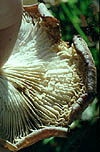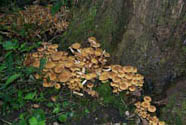
Cap distinctly greyish, often with sparse black fibrils
Gills quite deep, almost distant
White rhizomorphs attached to base of stalk
Growth habit solitary to several
No annulus
LentinoLignoTrich Subtribe

 Key to Gilled Mushrooms Key
Key to Gilled Mushrooms Key Agaricales Order
Agaricales Order White Spored Suborder
White Spored Suborder Tricholomataceae Family
Tricholomataceae Family Lignicolous Trich Subfamily
Lignicolous Trich Subfamily Normal LignoTrich Tribe
Normal LignoTrich Tribe
 This is the only species in this genus in the northern temperate zone. It is quite common on the east coast, west to Iowa, according to Lincoff (1987) , uncommon west of Ohio, according to A. E. Bessette, D. W. Fischer & A. R. Bessette (1997) . This (2001) has been a banner year for it in the midwest
This is the only species in this genus in the northern temperate zone. It is quite common on the east coast, west to Iowa, according to Lincoff (1987) , uncommon west of Ohio, according to A. E. Bessette, D. W. Fischer & A. R. Bessette (1997) . This (2001) has been a banner year for it in the midwest




